Evaluation of the Effect of Hamao Detention Pond on Excess Runoff from the Abukuma River in 2019 and Simple Remodeling of the Pond to Increase Its Flood Control Function
Abstract
:1. Introduction
2. Current Status of River Management for Flood Prevention and Possible River Improvement by New Policies
2.1. Current Status of Japan’s River Improvements for Flood Prevention
2.2. Topographical Features of the Upper Reaches of Rivers in Japan
2.3. Expandable Detention Pond That Uses Natural Terrain
3. Description of the Study Site
3.1. Overview of the Abukuma River Watershed
3.2. Terrain and Hydraulic Facilities of the HDP
4. Overview of the Large Flood in 2019
5. Methodology for Flood Analysis
5.1. Estimation of River Overflow Pattern from Water Level Data
5.1.1. Rate of River Overflow Flow at Points A and B
5.1.2. Backward Flow Rate from the Second Drainage Gate
5.2. Numerical Model for Flow Field Analysis
5.3. Iterative Calculation Method to Obtain the Entire Flow Field
- (1)
- First, an appropriate for the upstream end boundary condition is assumed, and the downstream boundary condition is set to perform a one-dimensional unsteady flow analysis considering the water exchange with the floodplain and the HDP. In this calculation, are given as the hydrographs shown in Figure 21, while the unknown variables are calculated using Equation (1).
- (2)
- The downstream end flow rate obtained by the calculation is compared with the Sukagawa observed flow rate , and the upstream flow rate is updated by subtracting their difference from the , in which is the time for floodwater to reach the downstream end from the upstream end.
- (3)
- Manning’s roughness coefficient, , is updated with reference to and obtained by the 3 L water gauges, and the longitudinal distribution of the highest water level obtained from the flood traces.
6. Numerical Simulation Results
7. Considerations for Remodeling the HDP to Improve Flood Control Capability
7.1. Remodeling Policy and Trial Design
- (a)
- When the water level in the river channel exceeds HWL, some of the river water starts flowing onto the floodplain from the overflow weir and flows downstream along the floodplain slope.
- (b)
- After the flood flow reaches the downstream end of the basin, it forms a pond that gradually expands upstream due to the backwater.
- (c)
- When the river water level outside the drainage gate becomes lower than the land side water level, the gate is opened, and the stored water is discharged to the river.
7.2. Numerical Simulation and Discussion
8. Conclusions
Author Contributions
Funding
Institutional Review Board Statement
Informed Consent Statement
Data Availability Statement
Acknowledgments
Conflicts of Interest
References
- Japan Society of Civil Engineers Hydraulic Engineering Committee: Investigation Team Report on Western Japan Heavy Rain Disaster in July 2018. March 2019. (In Japanese)
- Japan Society of Civil Engineers Hydraulic Engineering Committee: Investigation Team Report on Typhoon No. 19 Heavy Rain Disaster in 2019. September 2020. (In Japanese)
- Japan Society of Civil Engineers Hydraulic Engineering Committee: Investigation Team Report on Kyushu Heavy Rain Dis-aster in July 2020. April 2021. (In Japanese)
- Japan Meteorological Agency: Long-Term Changes in Sea Surface Temperature (the Sea Near Japan), October 2021. Available online: https://www.data.jma.go.jp/gmd/kaiyou/data/shindan/a_1/japan_warm/japan_warm.html (accessed on 18 December 2021). (In Japanese)
- Ministry of Land, Infrastructure, Transport and Tourism (MLIT): River Basin Disaster Resilience and Sustainability by All, Japan’s New Policy on Water-Related Disaster Risk Reduction, November 2020. Available online: https://www.mlit.go.jp/river/kokusai/pdf/pdf21.pdf (accessed on 18 December 2021).
- MLIT: Rivers in Japan, P.40. Publication of the Flood-Prone Area Maps. Available online: https://www.mlit.go.jp/river/kokusai/pdf/pdf01.pdf (accessed on 18 December 2021).
- MLIT: Plans of River Basin Disaster Resilience and Sustainability by All for Each Nationally Managed Class-A River, March 2021. Available online: https://www.mlit.go.jp/river/kasen/ryuiki_pro/index.html (accessed on 15 April 2021). (In Japanese)
- MLIT. MLIT: Manual for Creating Flood Prone Area Maps, 4th ed.; MLIT: Tokyo, Japan, 2015. (In Japanese) [Google Scholar]
- Okuma, T. A study on the function and etymology of open levees. In Historical Studies in Civil Engineering, Japan; Japan Society of Civil Engineers: Tokyo, Japan, 1987; Volume 7, pp. 259–266. (In Japanese) [Google Scholar]
- Nemoto, Y.; Nakayama, D.; Matsuyama, H. Reevaluation of Shingen-tsutsumi base on inundation flow simulation with special focus on the flood control facilities along the Midai River. Geogr. Rev. Jpn. Ser. A 2011, 84, 553–571. (In Japanese) [Google Scholar]
- Ishikawa, T.; Akoh, R. Assessment of flood risk management in lowland Tokyo areas in the seventeenth century by numerical flow simulation. Environ. Fluid Mech. 2019, 19, 1295–1307. [Google Scholar] [CrossRef]
- Teramura, J.; Shimatani, Y. Advantages of the Open Levee (Kasumi-Tei), a Traditional Japanese River Technology on the Matsuura River, from an Ecosystem-Based Disaster Risk Reduction Perspective. Water 2021, 13, 480. [Google Scholar] [CrossRef]
- Ishikawa, T.; Senoo, H. Hydraulic Evaluation of the Levee System Evolution on the Kurobe Alluvial Fan in the 18th and 19th Centuries. Energies 2021, 14, 4406. [Google Scholar] [CrossRef]
- Ishida, T.; Maeda, Y. Investigation in the disaster management plan for future climate change. In KASEN; Japan River Association: Tokyo, Japan, 2020; Volume 890, pp. 15–19. (In Japanese) [Google Scholar]
- Landform Classification Map for Flood Control. Available online: https://www.gsi.go.jp/bousaichiri/bousaichiri41043.html (accessed on 30 April 2018). (In Japanese)
- Ito, Y.; Akoh, R.; Ishikawa, T.; Maeno, S. Numerical study on flood control function of levee openings located along valley bottom plain rivers in the past. J. Jpn. Soc. Civ. Eng. B1 Hydraul. Eng. 2018, 74, 1531–1536. (In Japanese) [Google Scholar]
- MLIT: Low Cost, Long Life, Localized 3L Water Level Gauge. Available online: https://www.mlit.go.jp/river/kokusai/pdf/pdf03.pdf (accessed on 15 October 2021).
- MLIT: Investigation Committee Report on Abukuma River Upstream Embankment, June 2020. (In Japanese)
- Honma, H. Coefficient of flow volume on low overflow weir. Proc. JSCE 1940, 26, 635–645. (In Japanese) [Google Scholar]
- Akoh, R.; Ishikawa, T.; Kojima, T.; Tomaru, M.; Maeno, S. High-resolution modeling of tsunami run-up flooding: A case study of flooding in Kamaishi city, Japan, induced by the 2011 Tohoku tsunami. Nat. Hazards Earth Syst. Sci. 2017, 17, 1871–1883. [Google Scholar] [CrossRef] [Green Version]
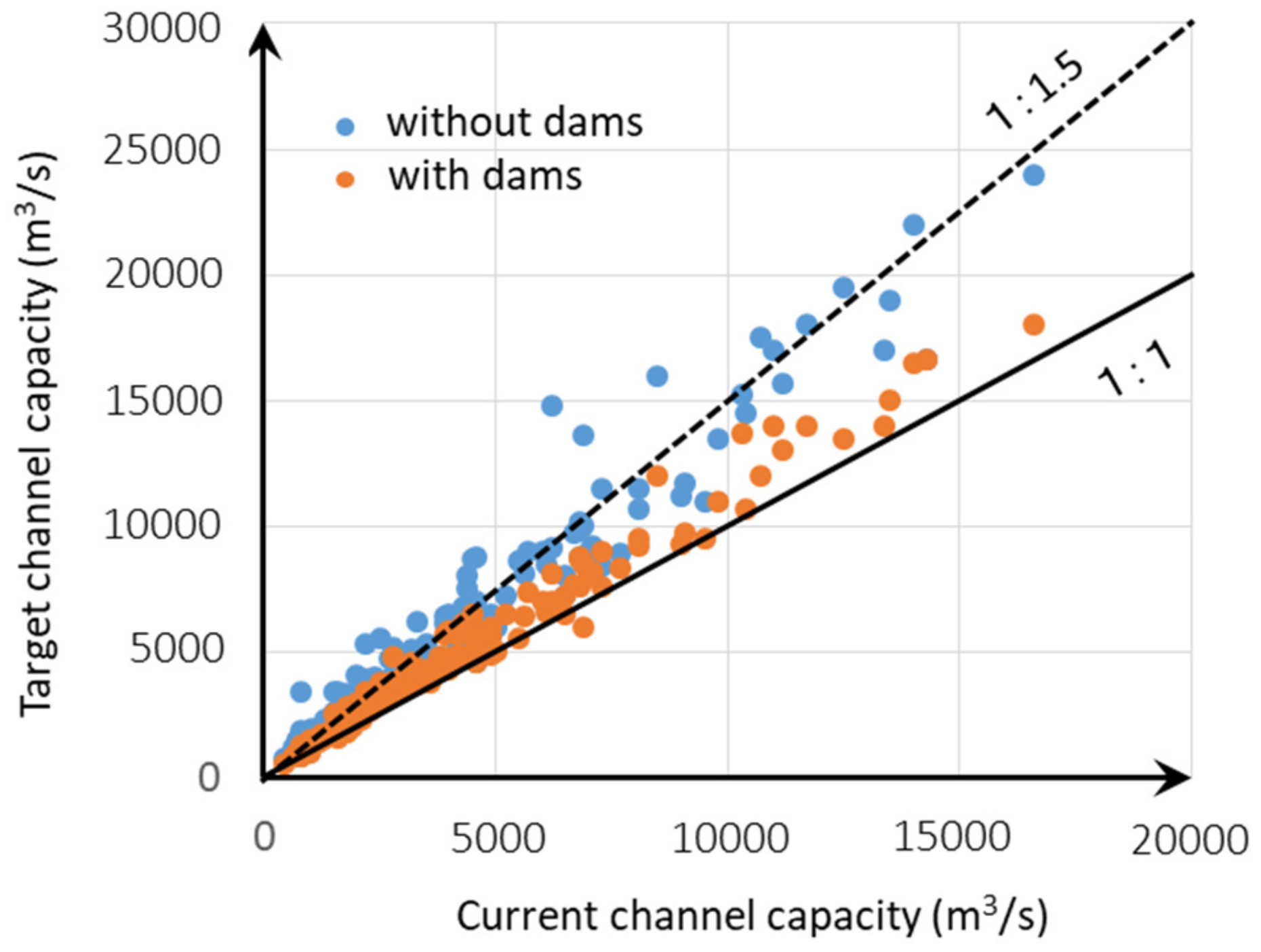

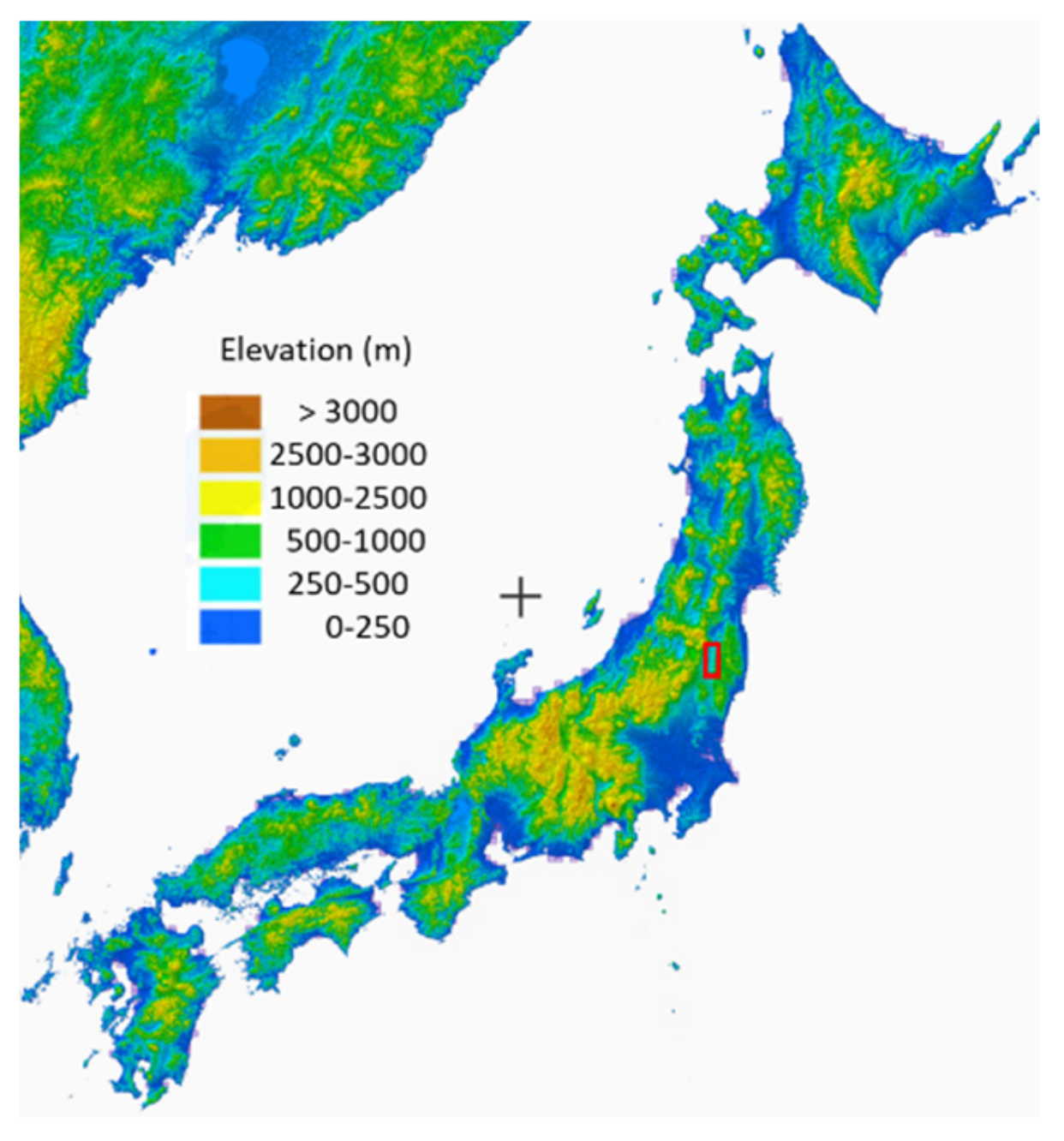





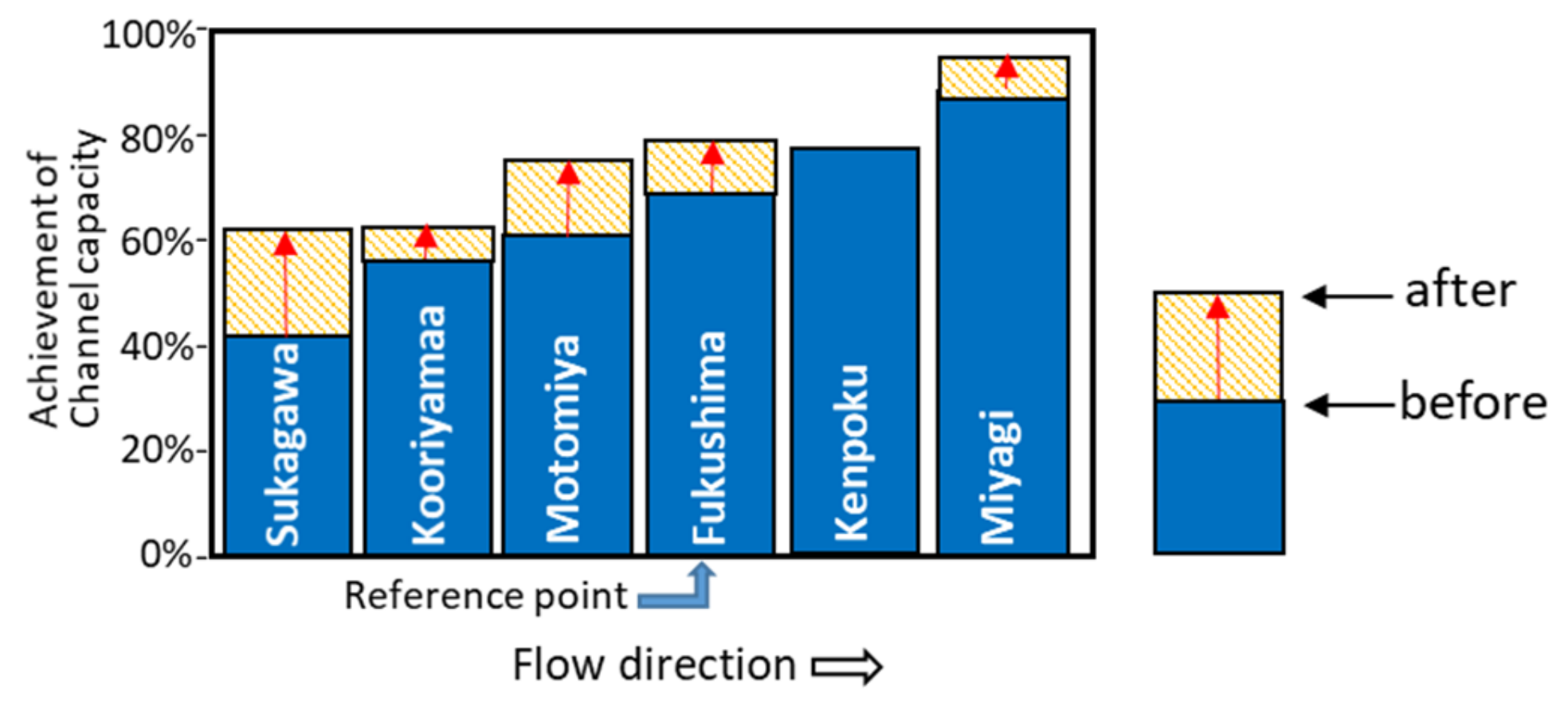
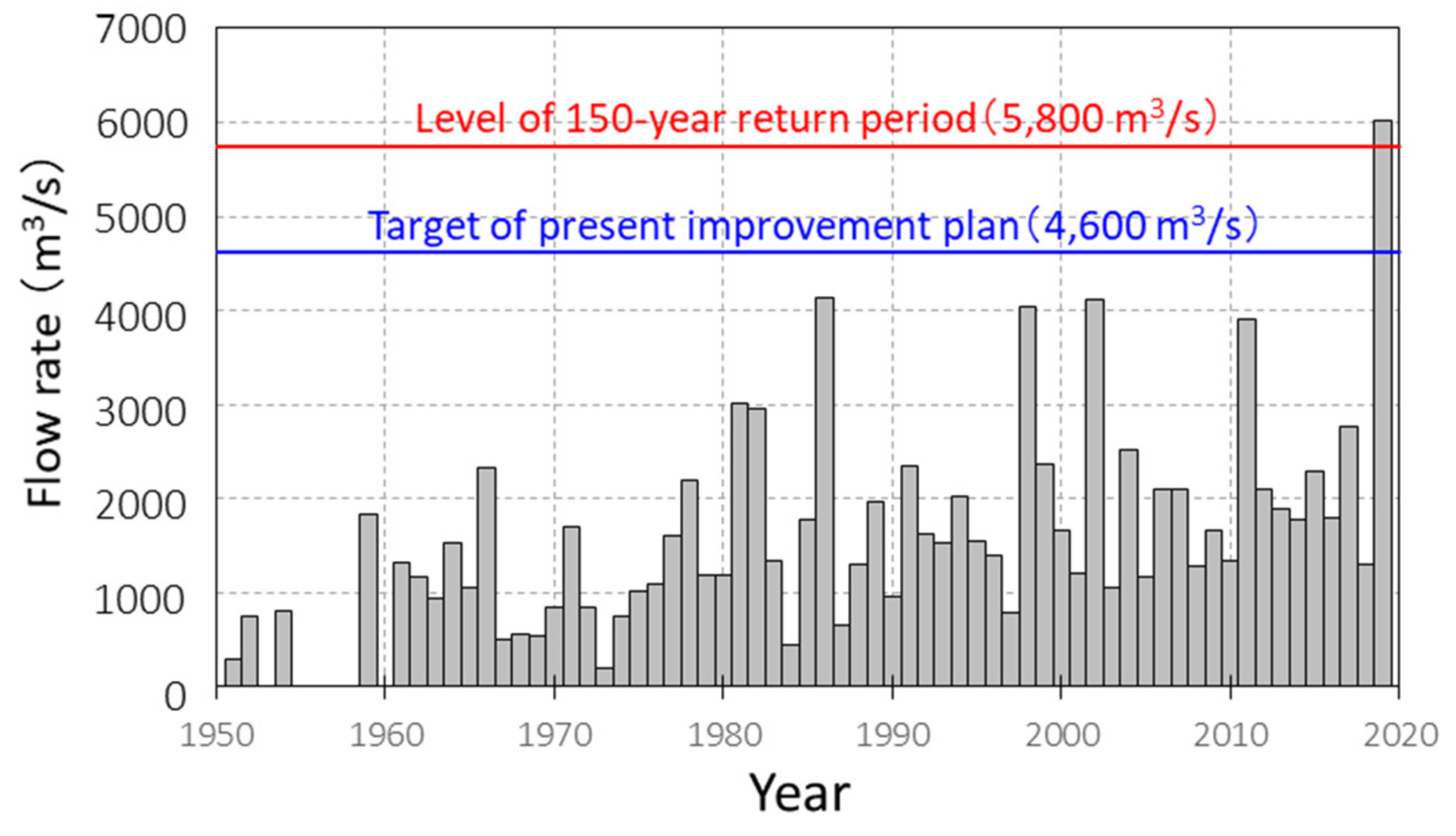
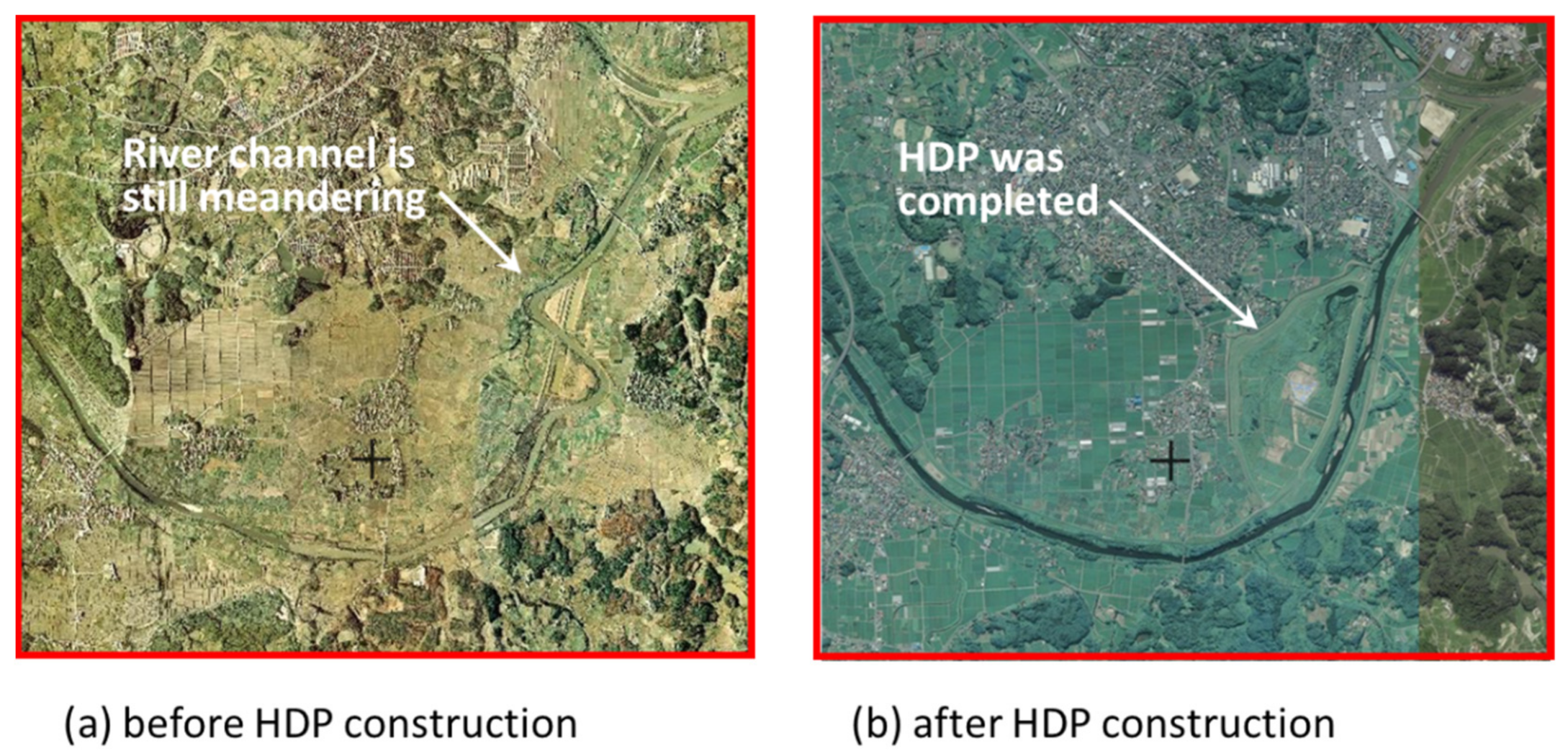
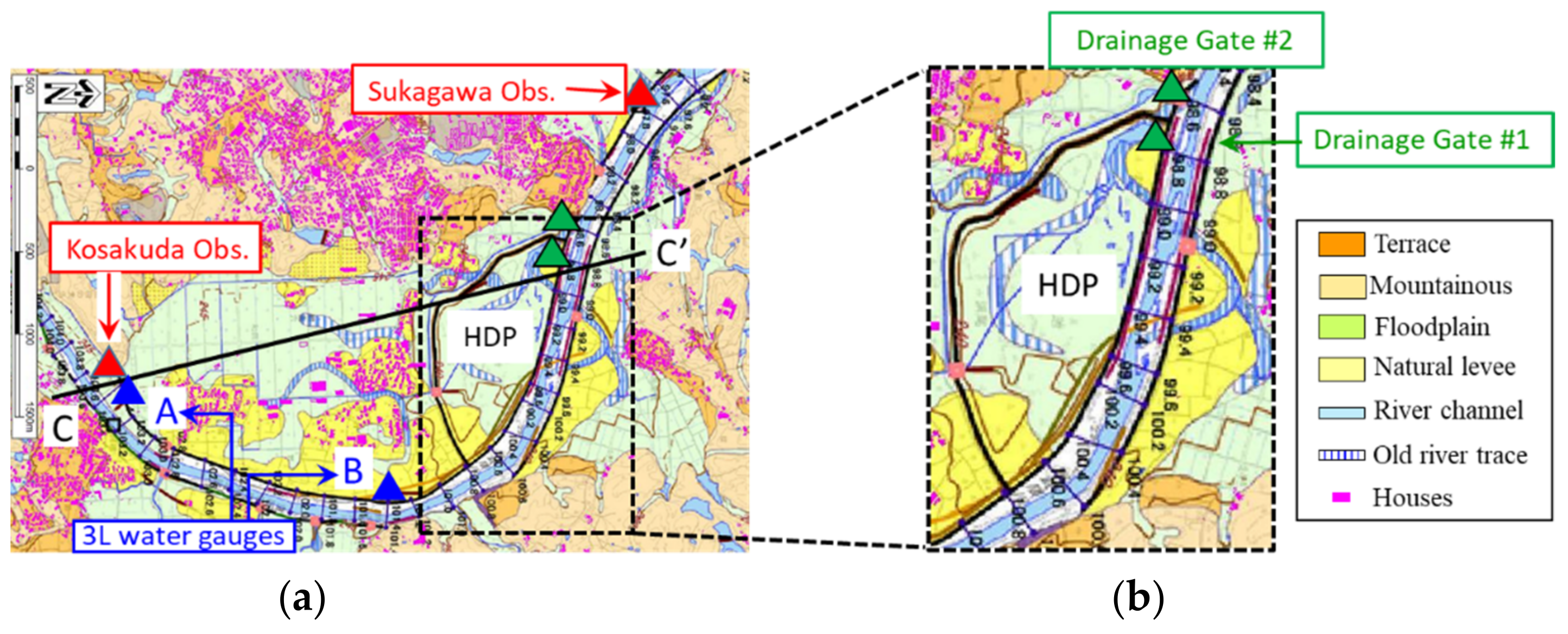


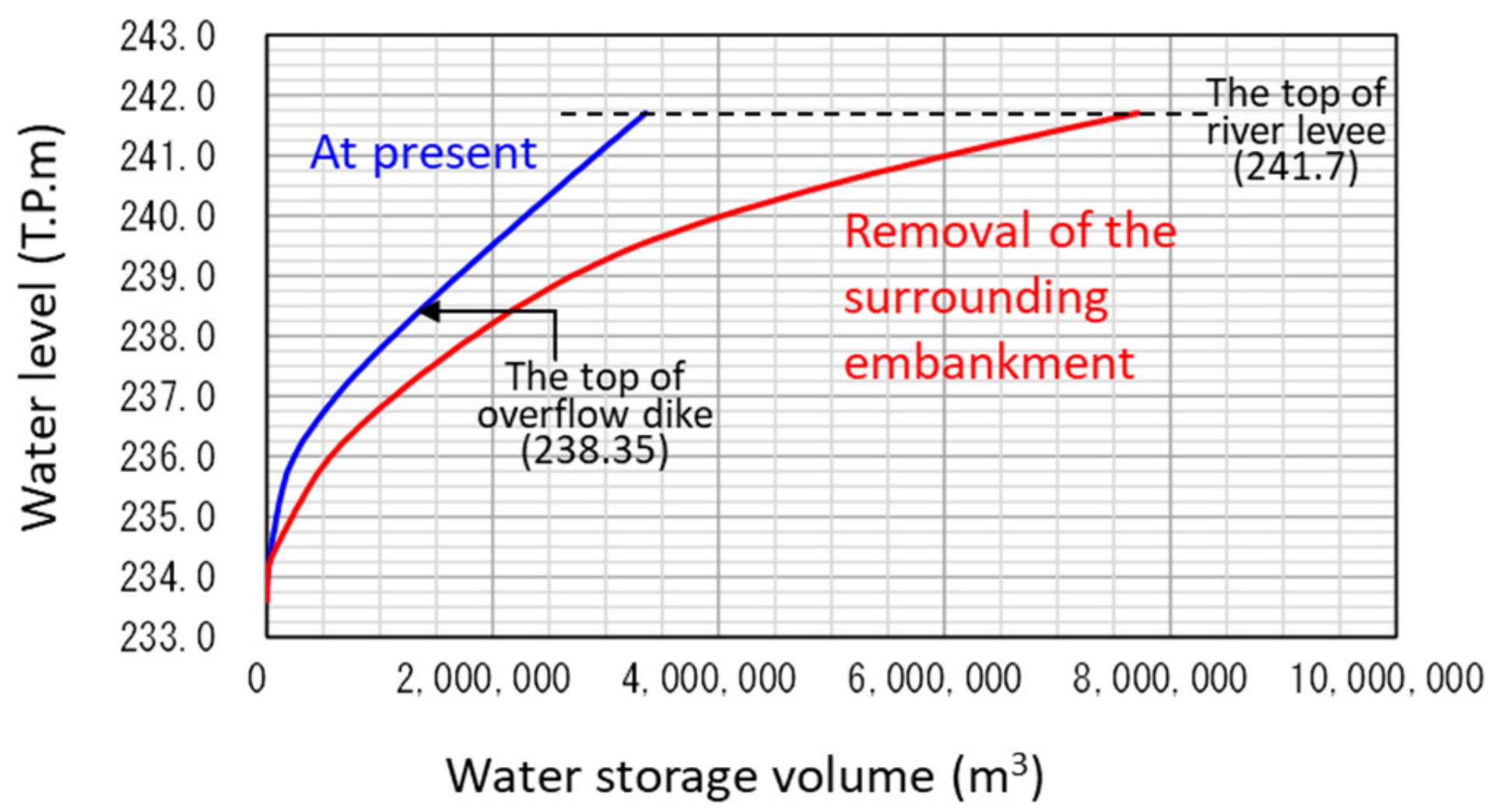
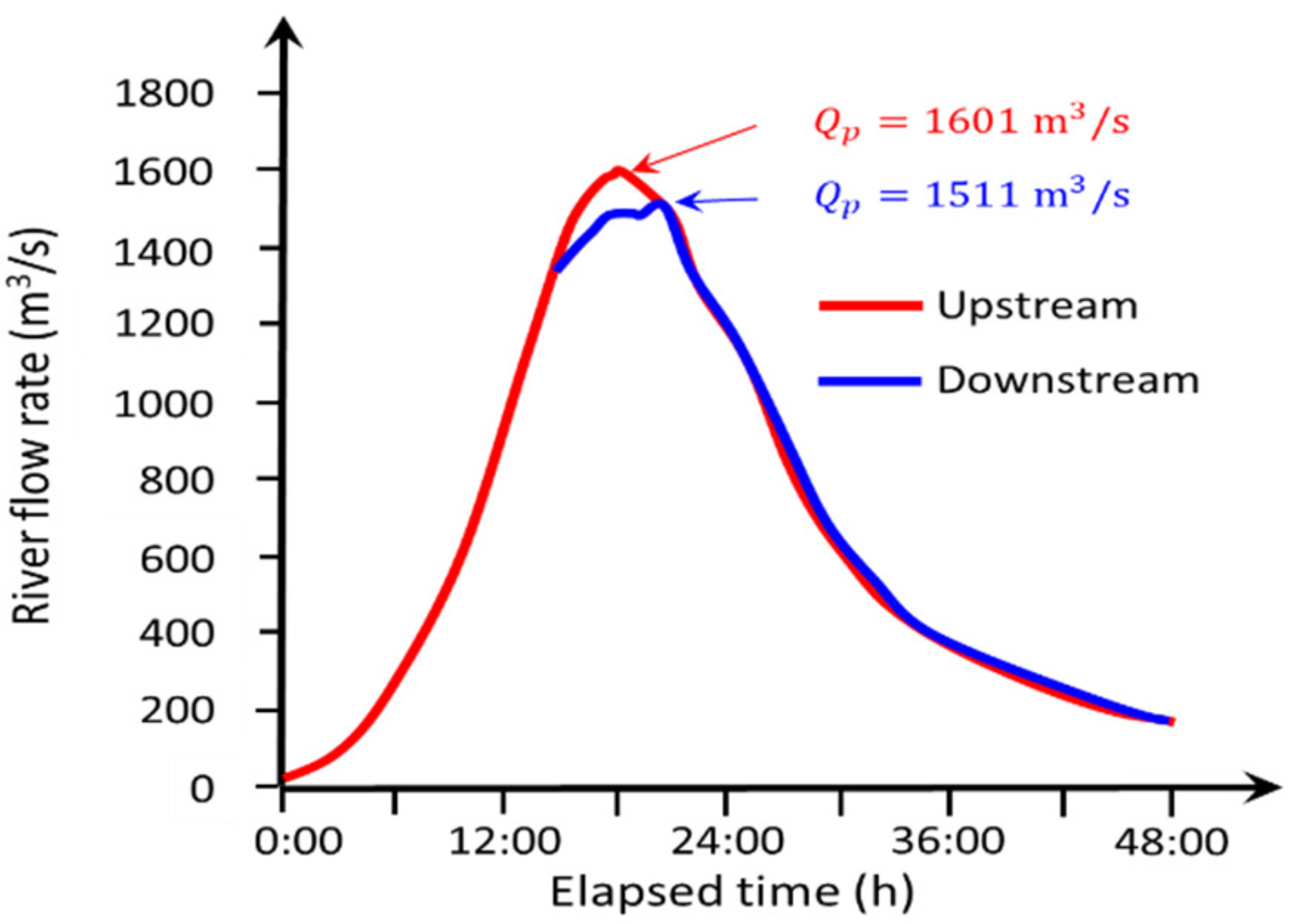
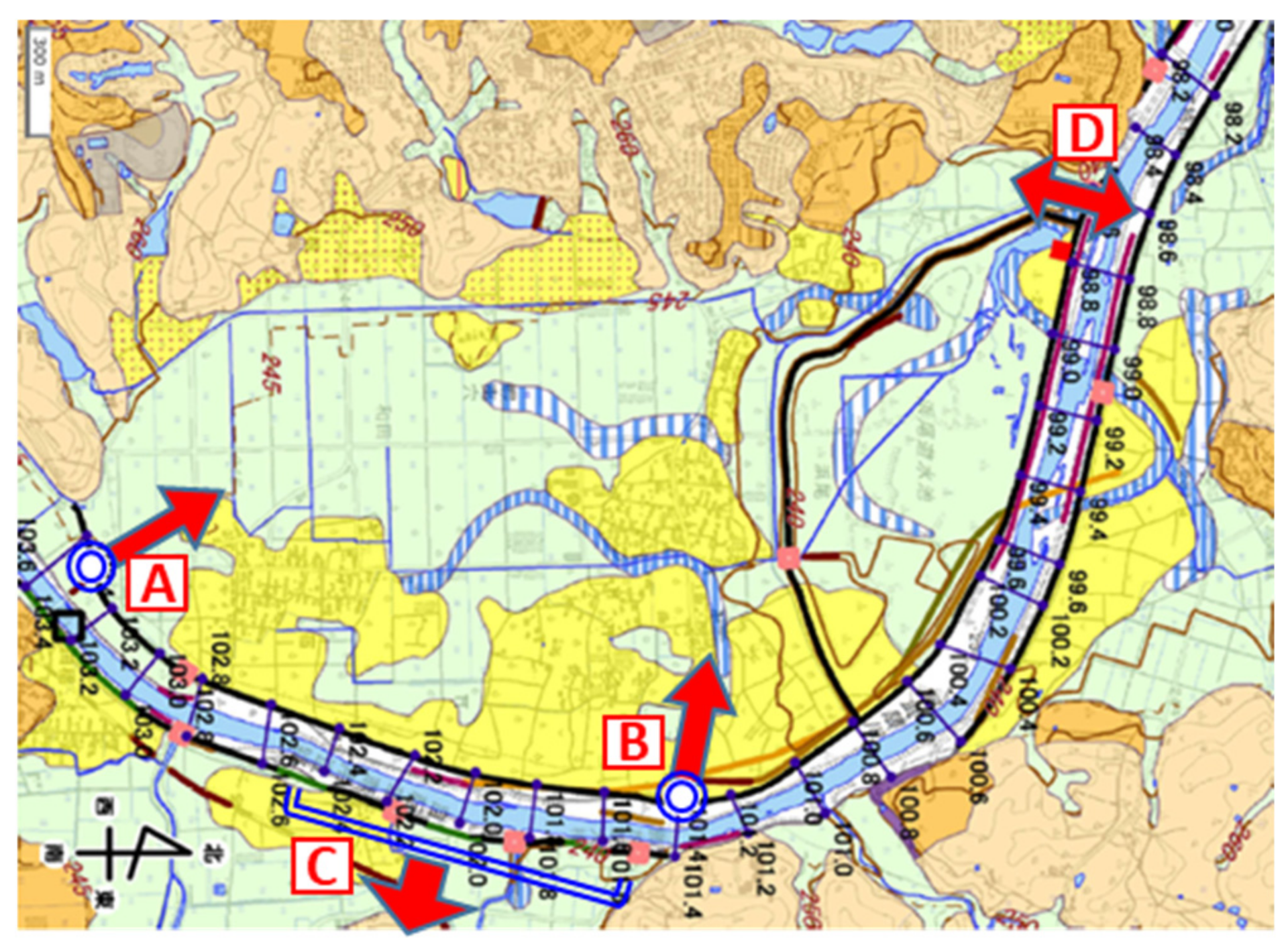
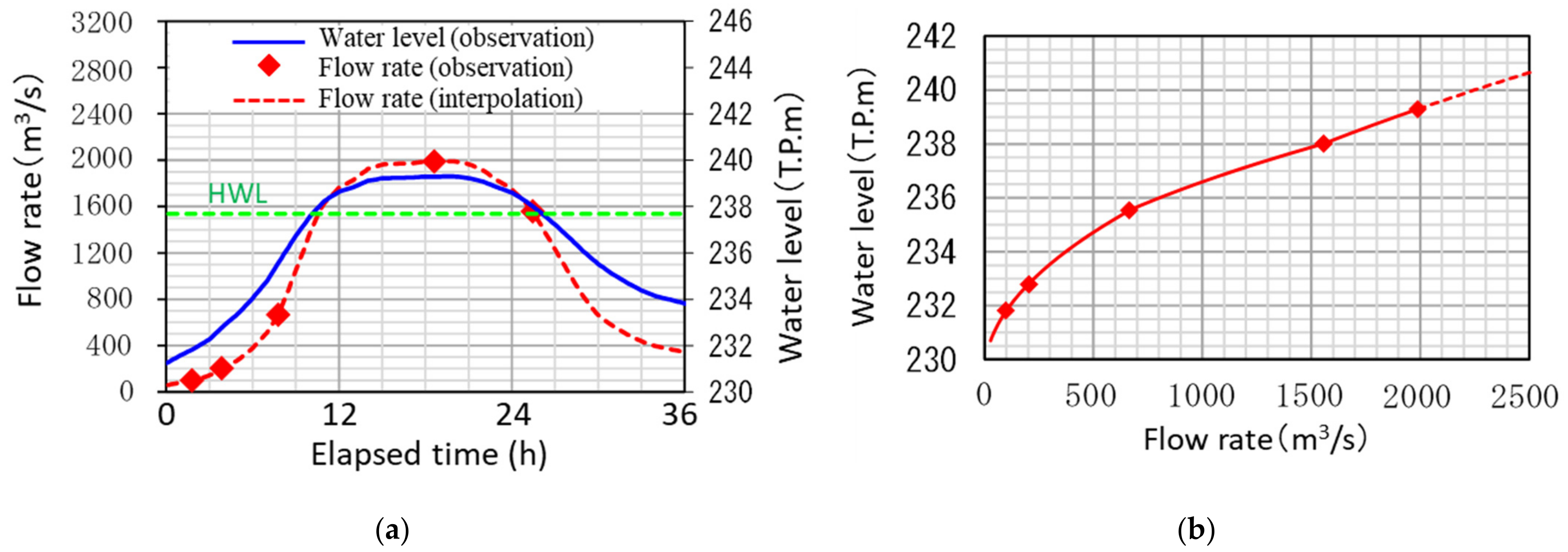
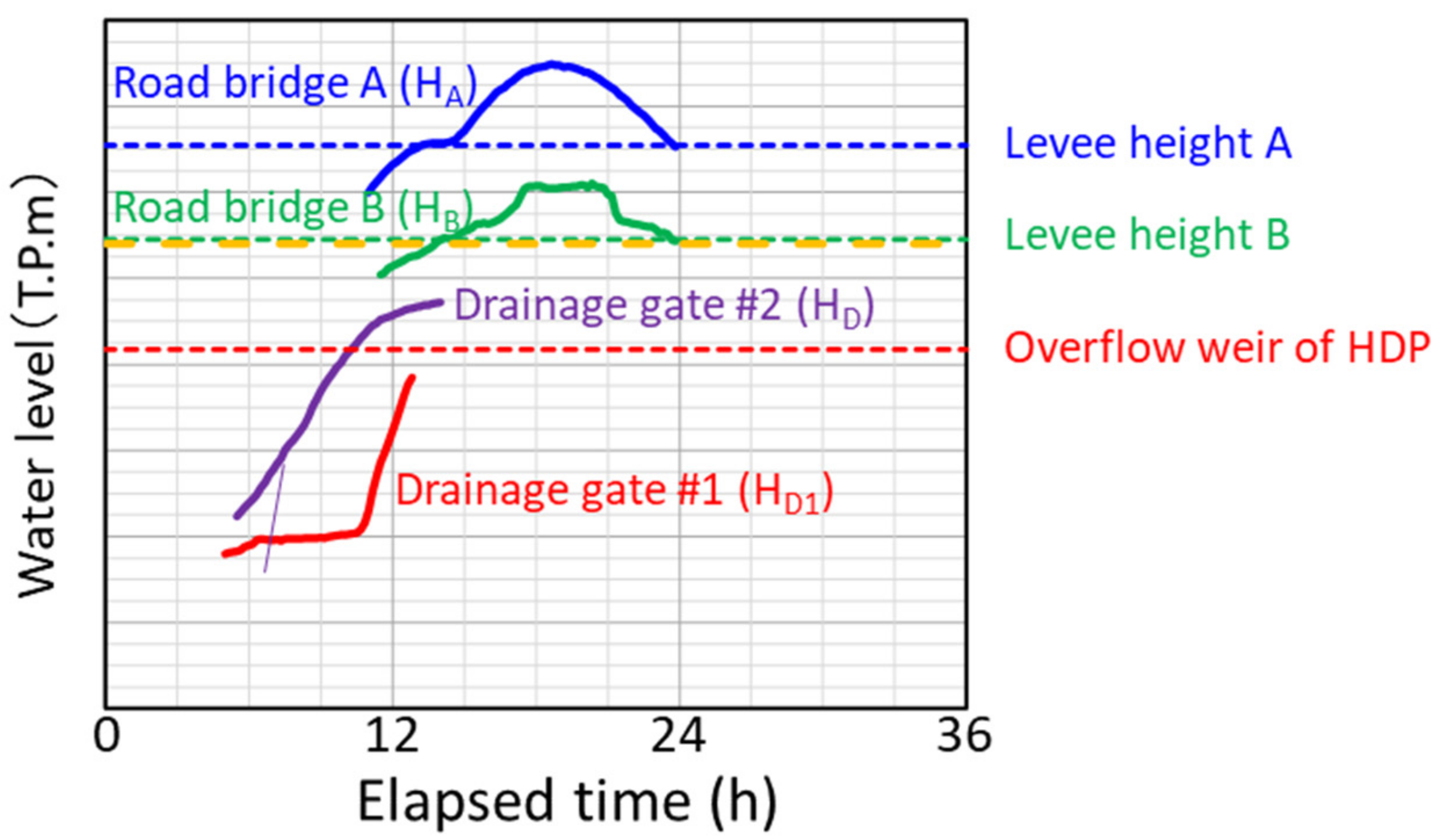

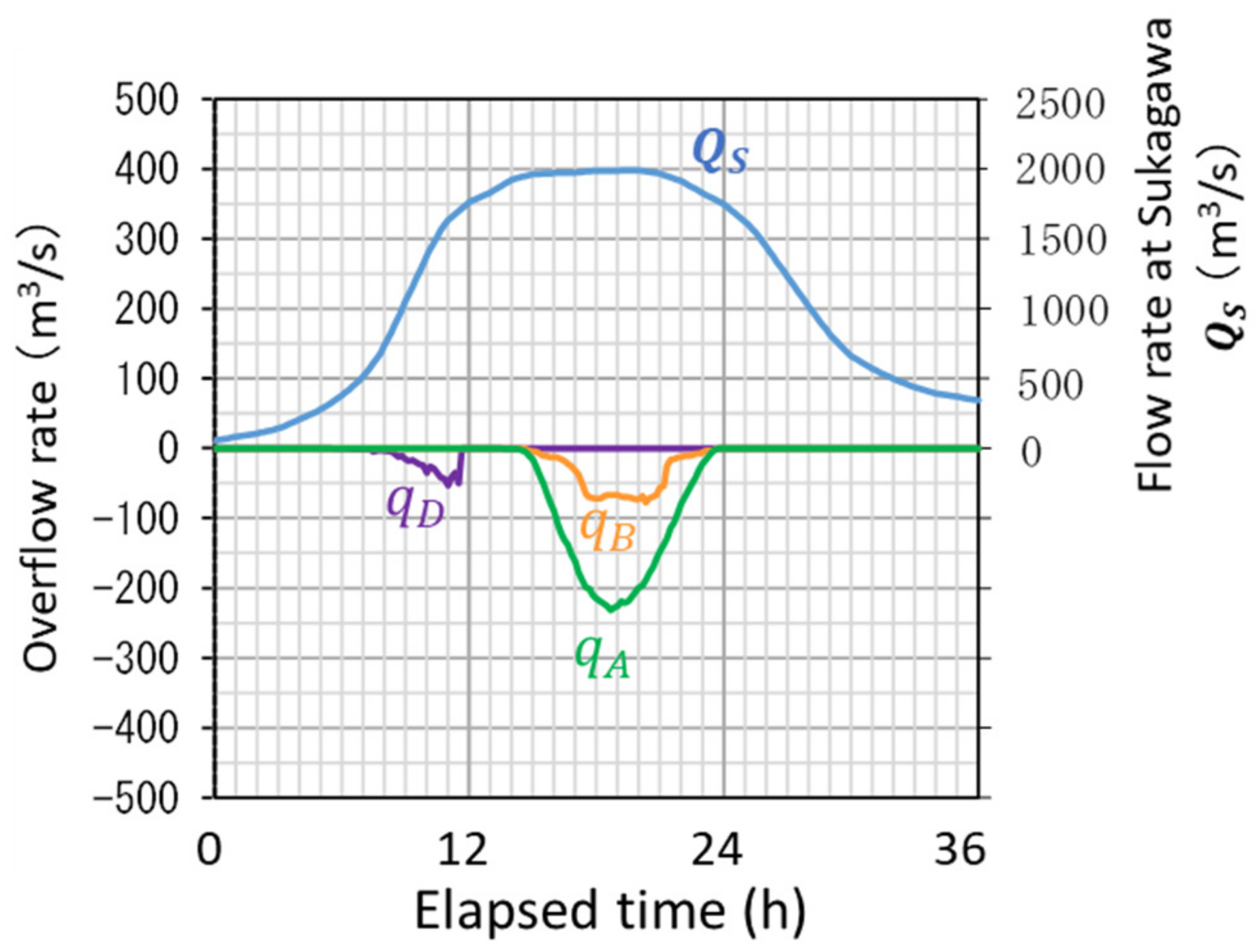
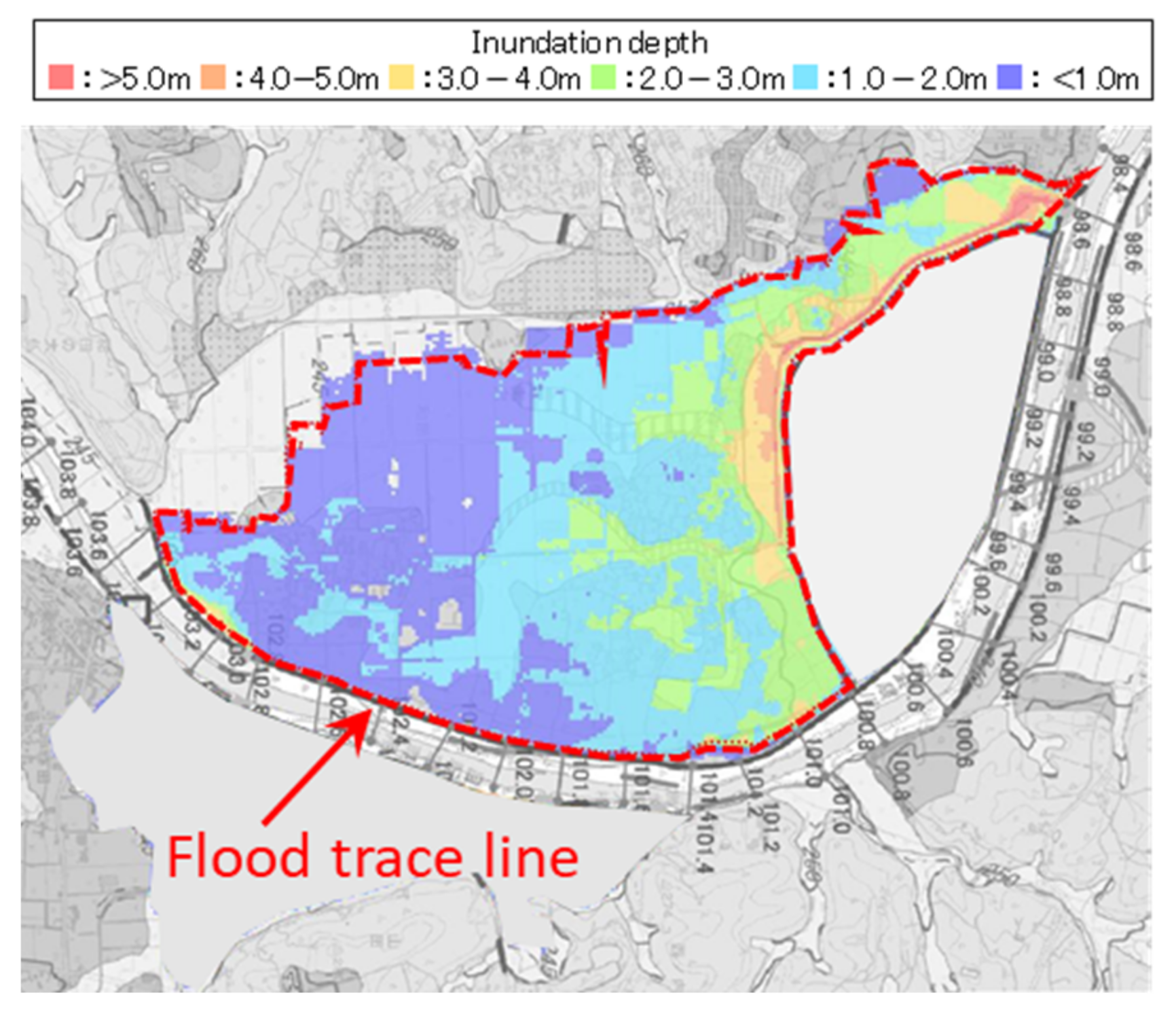


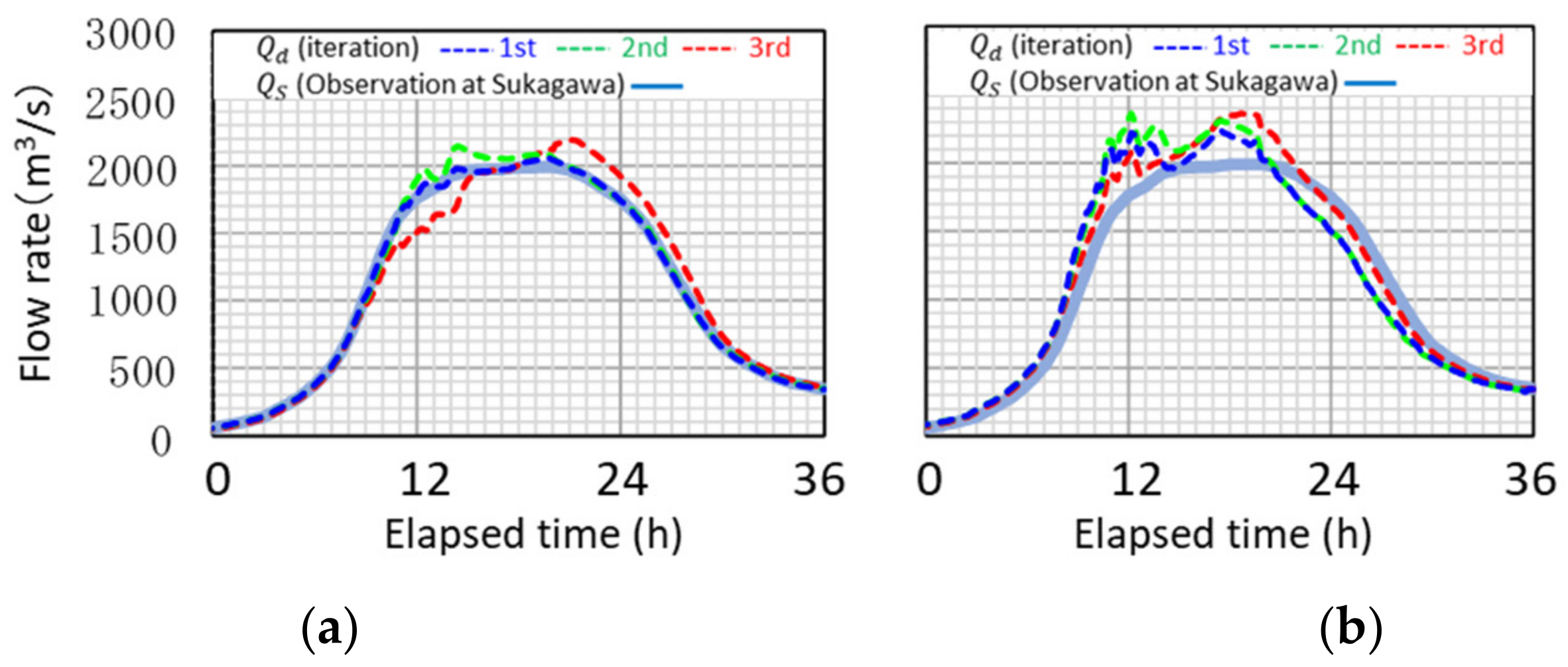
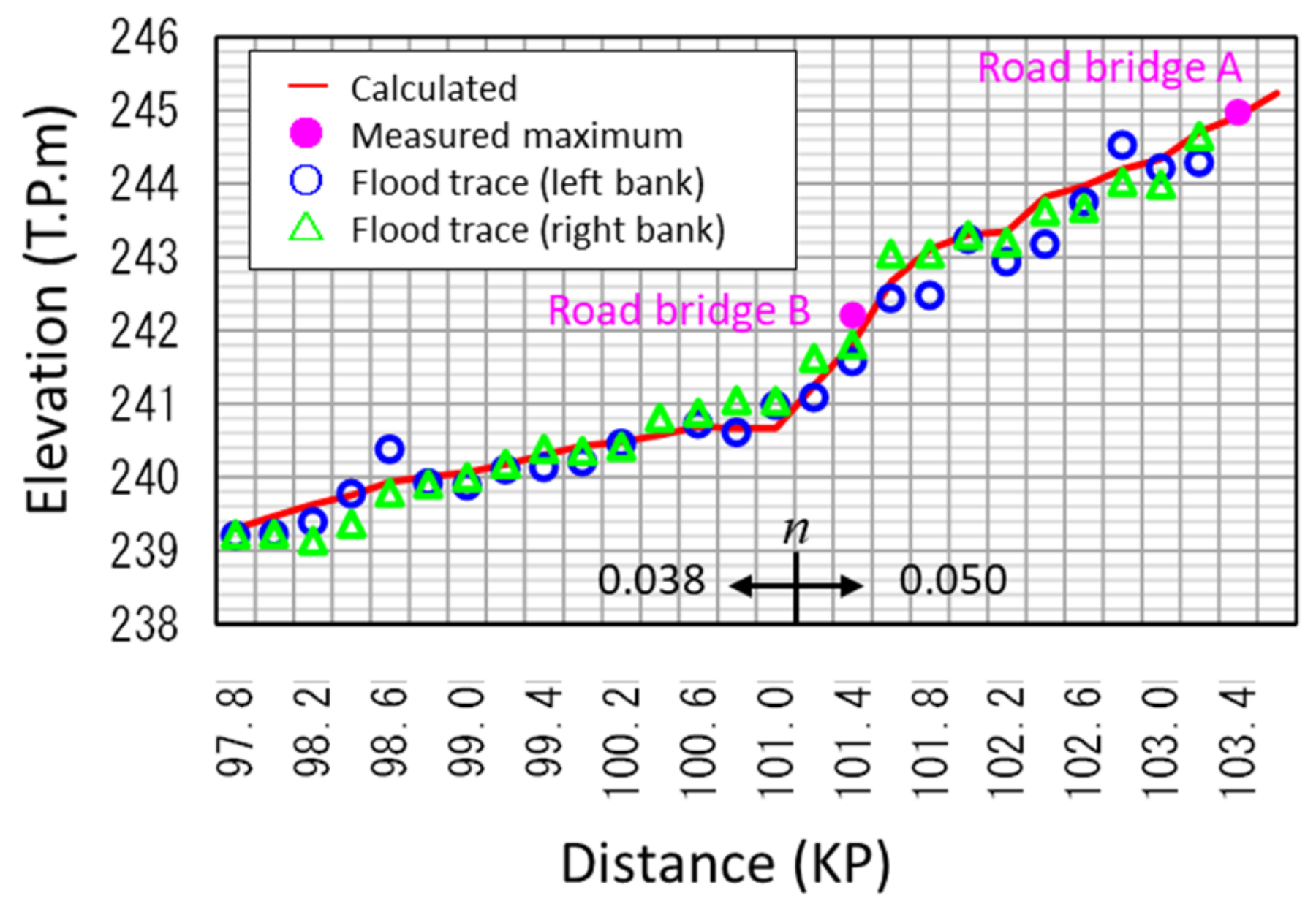
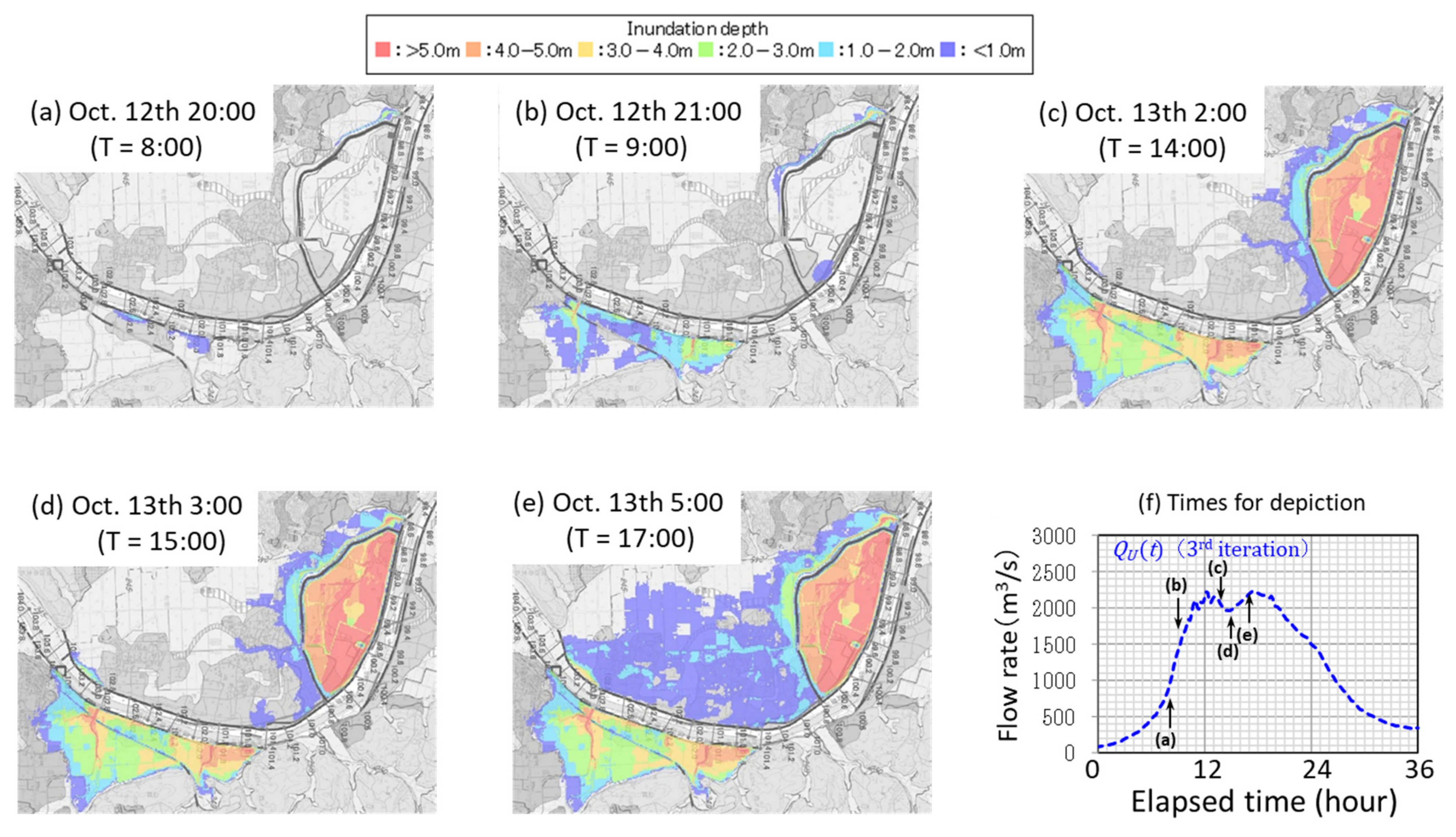
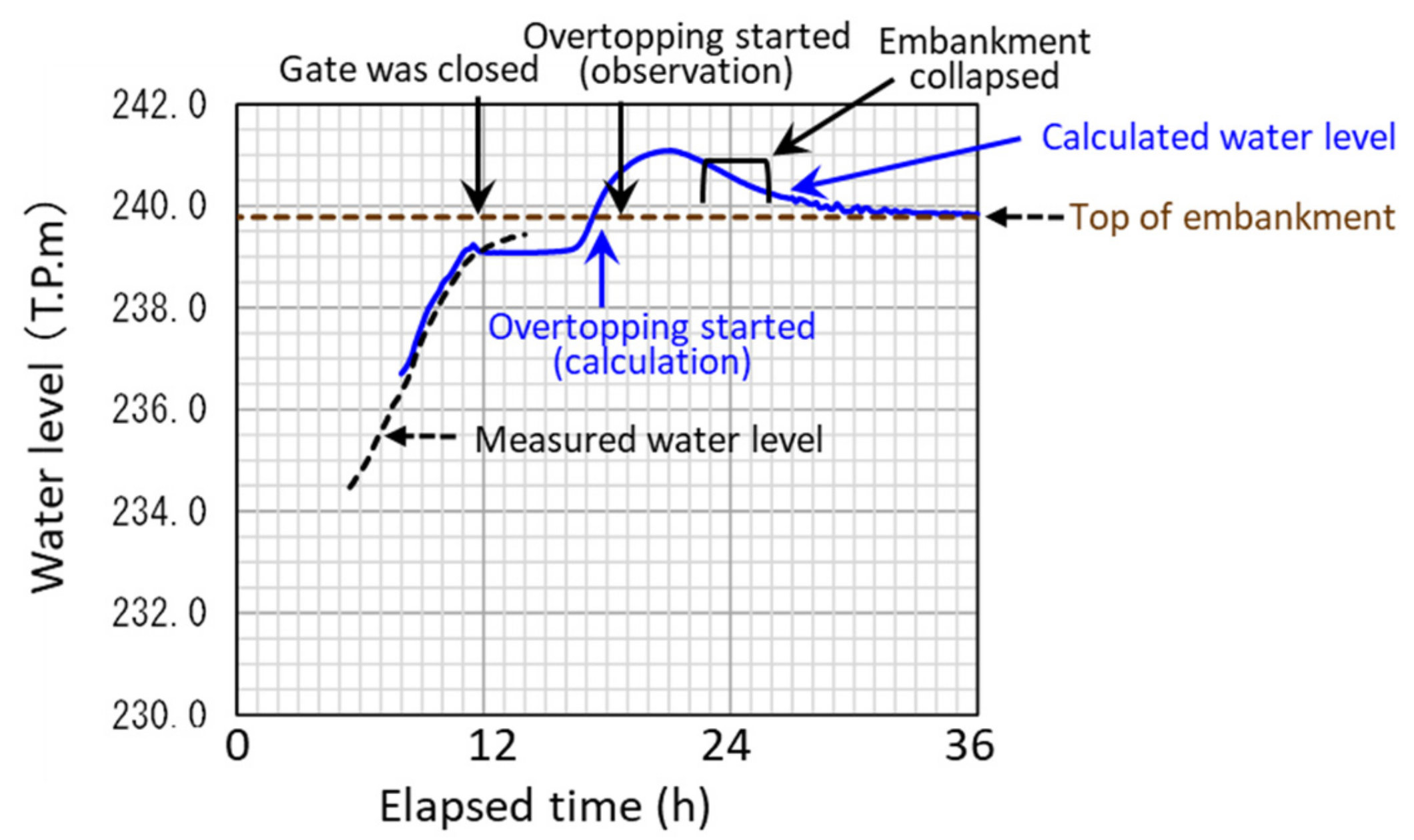
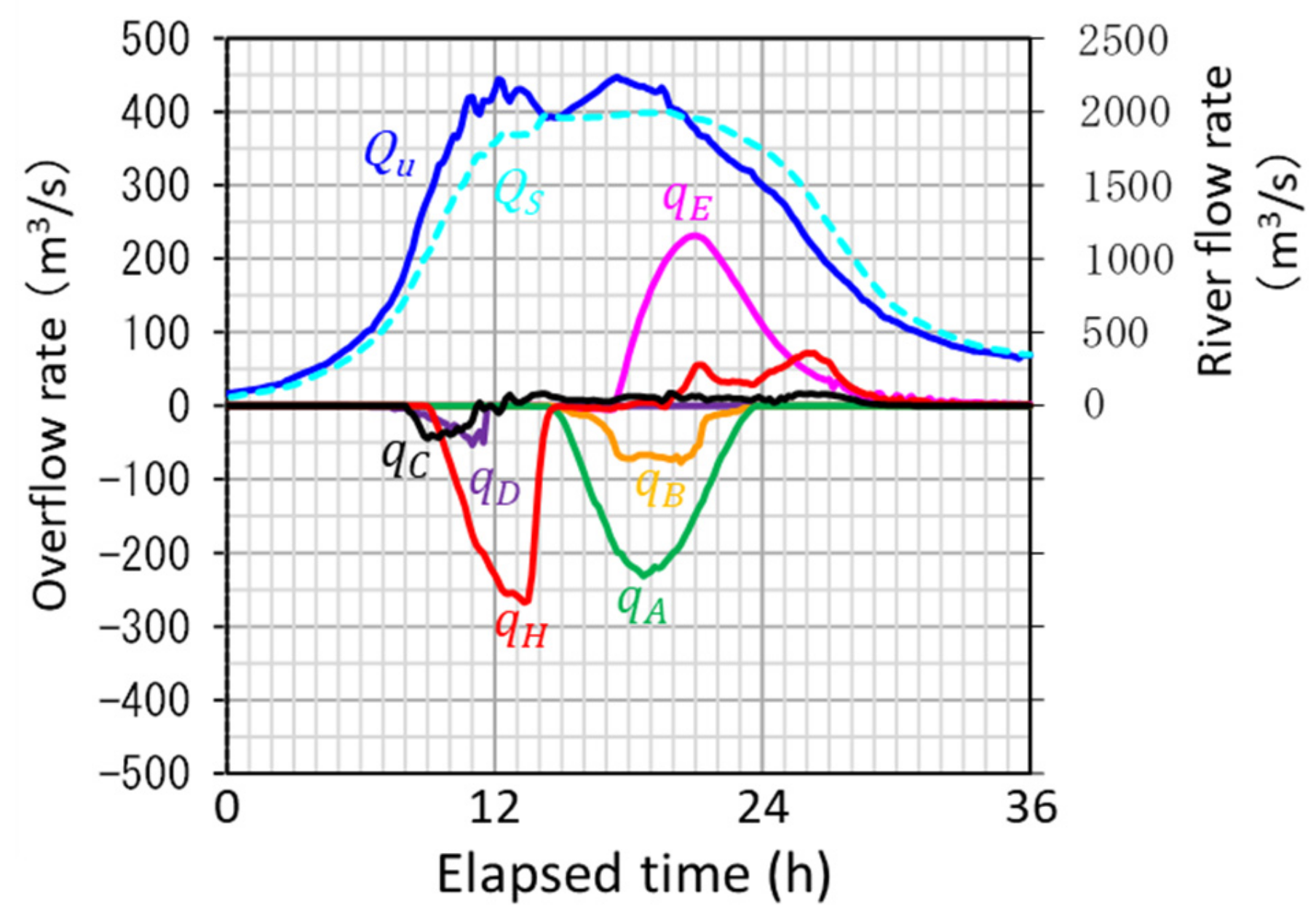
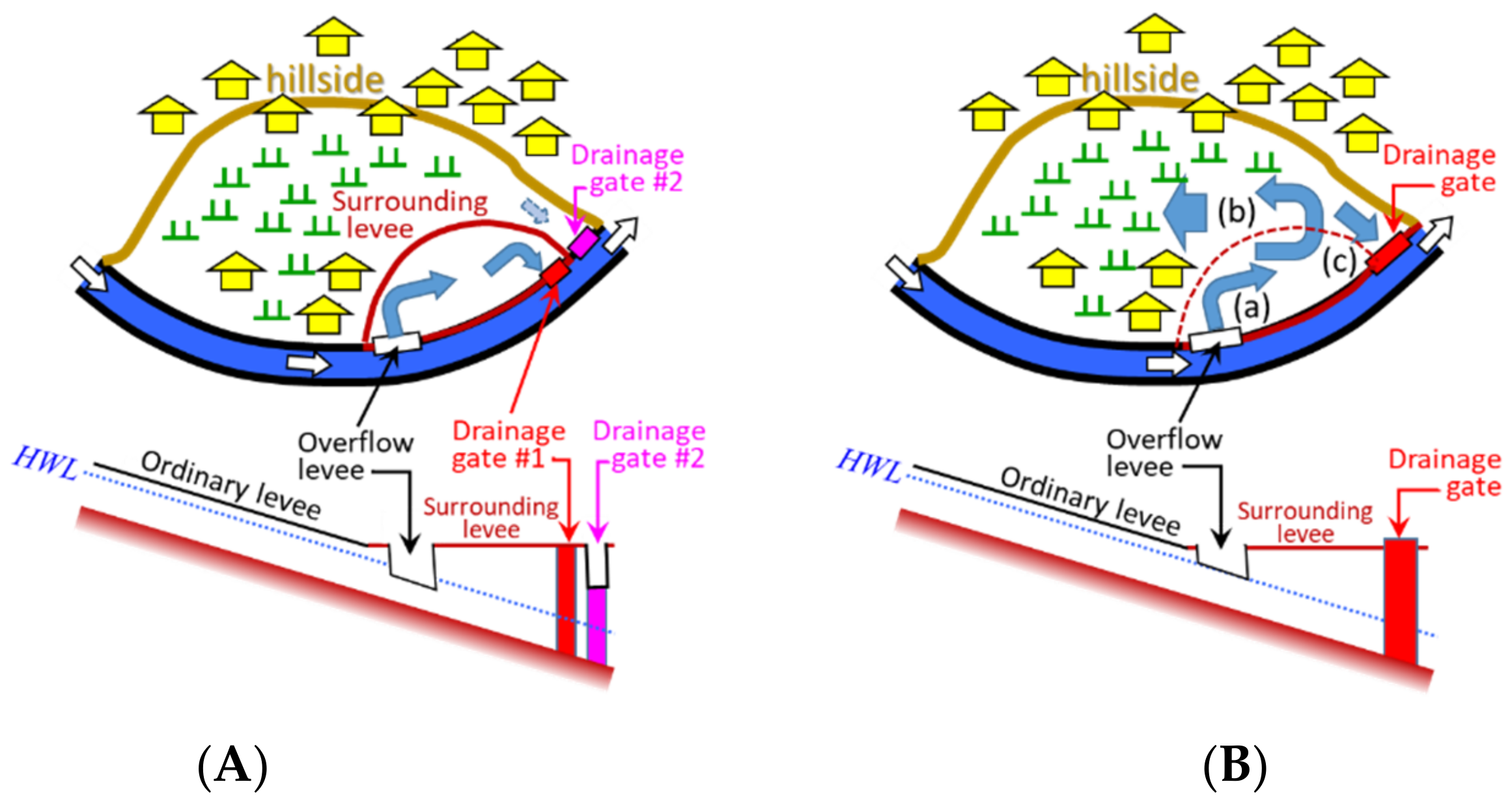

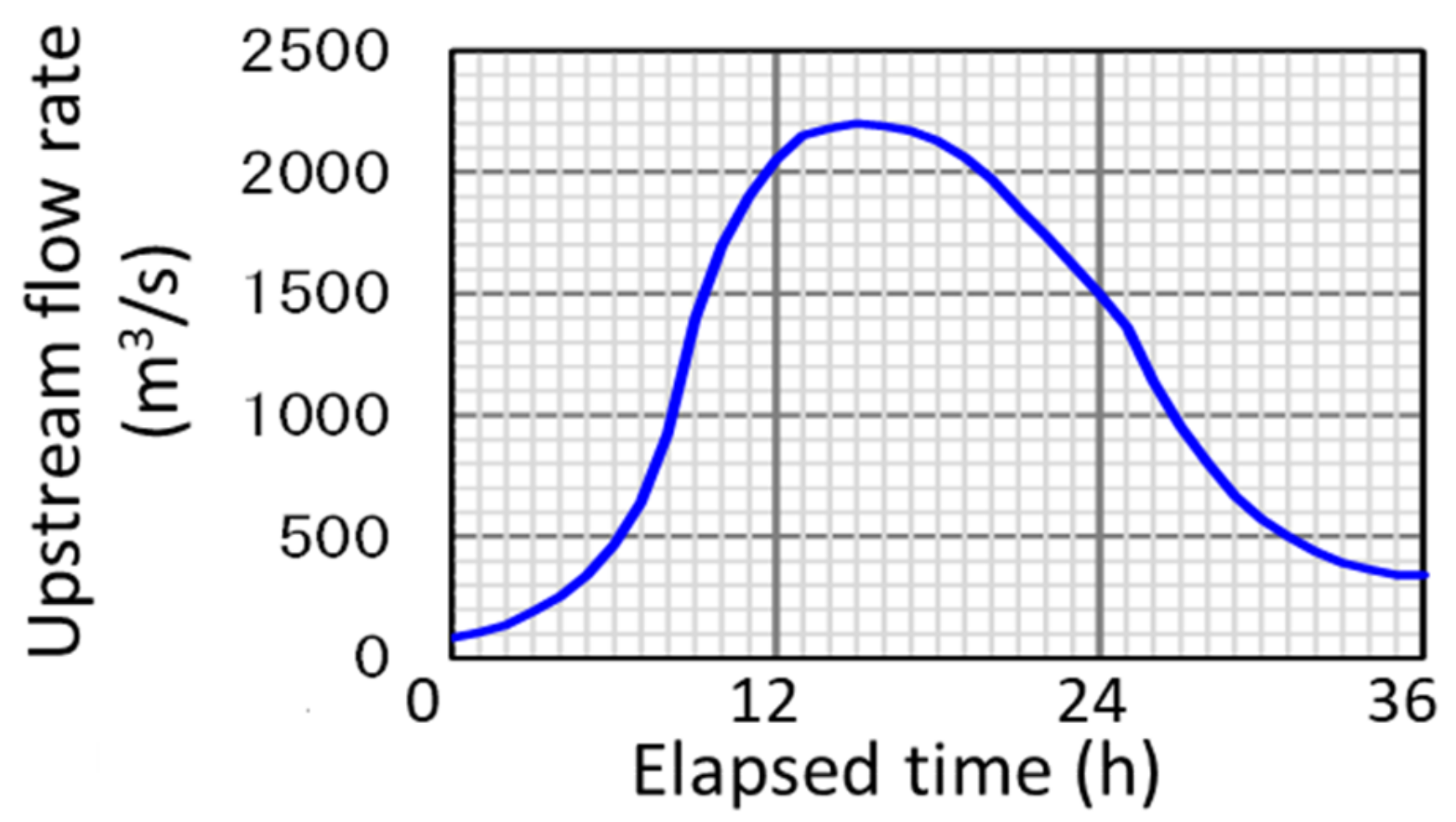



| Measurement Point | Symbol | Measurement Duration | Elapsed Time |
|---|---|---|---|
| Sukagawa (water level) | 12th 12:00–14th 0:00 | 0:00–36:00 | |
| Sukagawa (flow rate) | 12th 12:00–14th 0:00 | 0:00–36:00 | |
| Road bridge A | 12th 23:00–13th 11:50 | 11:00–23:50 | |
| Road bridge B | 12th 23:00–13th 11:50 | 11:00–23:50 | |
| Discharge gate #1 | 12th 17:00–13th 0:50 | 5:00–12:50 | |
| Discharge gate #2 | 12th 17:30–13th 2:30 | 5:30–14:30 | |
| River channel (flood peak trace) | After flood |
Publisher’s Note: MDPI stays neutral with regard to jurisdictional claims in published maps and institutional affiliations. |
© 2022 by the authors. Licensee MDPI, Basel, Switzerland. This article is an open access article distributed under the terms and conditions of the Creative Commons Attribution (CC BY) license (https://creativecommons.org/licenses/by/4.0/).
Share and Cite
Harada, S.; Ishikawa, T. Evaluation of the Effect of Hamao Detention Pond on Excess Runoff from the Abukuma River in 2019 and Simple Remodeling of the Pond to Increase Its Flood Control Function. Appl. Sci. 2022, 12, 729. https://doi.org/10.3390/app12020729
Harada S, Ishikawa T. Evaluation of the Effect of Hamao Detention Pond on Excess Runoff from the Abukuma River in 2019 and Simple Remodeling of the Pond to Increase Its Flood Control Function. Applied Sciences. 2022; 12(2):729. https://doi.org/10.3390/app12020729
Chicago/Turabian StyleHarada, Shouta, and Tadaharu Ishikawa. 2022. "Evaluation of the Effect of Hamao Detention Pond on Excess Runoff from the Abukuma River in 2019 and Simple Remodeling of the Pond to Increase Its Flood Control Function" Applied Sciences 12, no. 2: 729. https://doi.org/10.3390/app12020729
APA StyleHarada, S., & Ishikawa, T. (2022). Evaluation of the Effect of Hamao Detention Pond on Excess Runoff from the Abukuma River in 2019 and Simple Remodeling of the Pond to Increase Its Flood Control Function. Applied Sciences, 12(2), 729. https://doi.org/10.3390/app12020729





